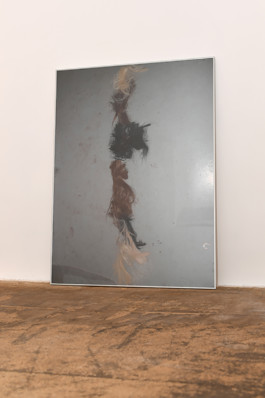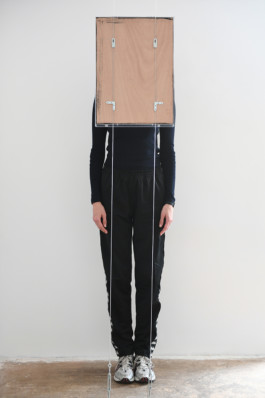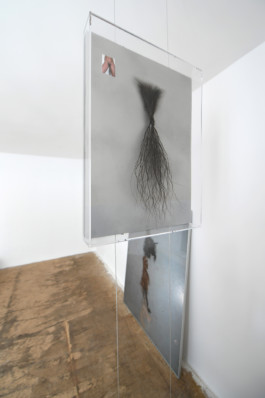


Registro 6: Manglar
by Carlota Guerrero
Curated by Mariona Valdés
16 February — 31 March 2023
“What generally passes for nature in the bourgeois context of delusion is merely the scar tissue of mutilation.” (Theodor Adorno in 'Minima Moralia: Reflections From Damaged life', 1951)
Filmed in a natural mangrove reserve in Veracruz (México), one of many territories subject to environmental exploitation, the artist Carlota Guerrero presents “Registro 6: Manglar”, a video installation that portrays the ritualistic experience of a group of eight women in August 2021.
The domination of women has offered a crucial link, both symbolically and socially, to the domination of Earth. This association has been examined by many feminist scholars since the seventies, who have broadly observed a general tendency in patriarchal societies to identify women with nature, earth, and matter, while associating males with transcendent spirit, sky, and intellect.
It is precisely up in the sky from where God is presented to us. Particularly in the Western context, our origins have been defined by the masculine image of God the Father, of the Creator God, who is able to subdue all things to Himself. Of course, this is a cultural product which has been perpetuated after centuries of masculine religious domination, and that clearly does not live up to a universalist vision capable of uniting humanity by understanding its differences of expression.
Symbolic representations do not function as mere images isolated from their socio-political reality; they have historically served as catalysts for gender metaphors. Amongst all these symbols, the religious and mythological appear especially relevant, due to their capacity of representing a power that human beings have interpreted as divine and unquestionable. As the feminist theologian Isabel Gómez brilliantly points out, “un Dios descrito como varón se convierte en un varón Dios” (a God described as male becomes a godly male).
The historical structuring of current society, the dissemination of an androcentric symbology that attributed the creative power of life to a male God, together with the recurring mutilation of female symbols linked to power, has had a brutal impact on the shaping of our common imaginary. As a response to this systematic and symbolic violence, “we must go back to the womb, to the earth, and seek to draw its primitive energy as the basic condition for humanity” (Ivone Gebara, 2012)
In this vein, Carlota Guerrero questions the effect of the omnipresent male gaze and claims for the exploration and realisation of the female point of view. Through her work, the artist aims to fill this historical imagination gap by continuously generating a new feminist symbology that results in the creation of contemporary myths, vestiges, and staged rituals.
Between performative experience and photography, Guerrero’s creations differ from ordinary photographic works. While it is true that the medium enables her to document the experiences of communion among women she obsessively creates, the resulting images remain secondary; they are vestiges of these past encounters.
On this occasion, “Registro 6: Manglar” documents, on the one hand, the encounter of Samai, Camila, Nika, Monse, Valeria, Sarahí, Fernanda and GG in the mangroves, and the individual urban experience of Carmen on the other.
These confronted scenarios are connected through the central image of a giant and communal clitoris. Physically and symbolically the most mutilated organ in the history of humankind, it guides the bodies and experiences of all the nine women as they navigate the orchestrated ritual towards the centre of the earth.
As paths through which the female millenary wound might be healed, Guerrero’s oeuvre brings the utopia closer to reality by presenting a series of poetically fabricated myths of a female past that has not existed but makes space for the future.
—Mariona Valdés

'Registro 6: Manglar' solo show by Carlota Guerrero at Sainte Anne Gallery. Overview.

Organised pain (2023) by Carlota Guerrero. Wood, nails, aluminum. 253 x 163 x 20 cm. Artwork part of installation 'Registro 6: Manglar' by Carlota Guerrero at Sainte Anne Gallery.

Registro 6: Manglar (2021) by Carlota Guerrero. Video installation, two screens, 5 minutes, 16 seconds

'Registro 6: Manglar' solo show by Carlota Guerrero at Sainte Anne Gallery. Overview.

Canales (2022) by Carlota Guerrero. Print. Hahnemühle Rag Baryta Paper. 93 x 123 cm

Edition of 17 art books. Registro 6: Manglar (Memoria)(2023) by Carlota Guerrero. Paper, fabric, thread, wood, nails. 14,8 x 19 x 10 cm

Registro 6: Manglar (Memoria) (2023) by Carlota Guerrero. Art book. Unique piece. Artist's hair, paper, fabric, thread, wood, nails. 14,8 x 19 x 10 cm

Registro 6: Manglar (Memoria) (2023) by Carlota Guerrero. Art book. Unique piece. Artist's hair, paper, fabric, thread, wood, nails. 14,8 x 19 x 10 cm

Registro 6: Manglar (Memoria) (2023) by Carlota Guerrero. Edition of 17 art books. Paper, fabric, thread, wood, nails. 14,8 x 19 x 10 cm

'Registro 6: Manglar' solo show by Carlota Guerrero at Sainte Anne Gallery. Overview

Raíz (2023) by Carlota Guerrero and Sonam Solanki. Human hair, nylon, methacrylate, paper, wood. 35 x 48 x 5 cm

Carmen (2021), Carlota Guerrero